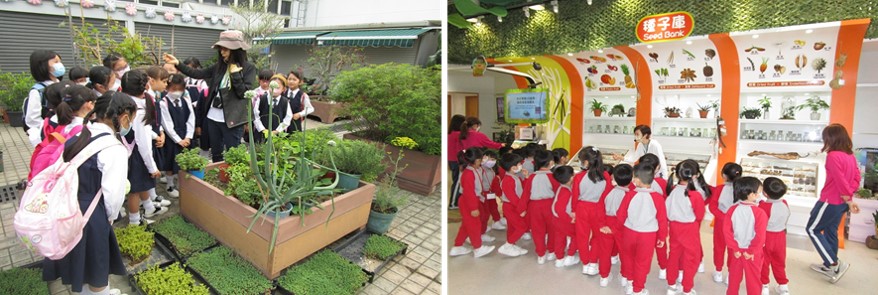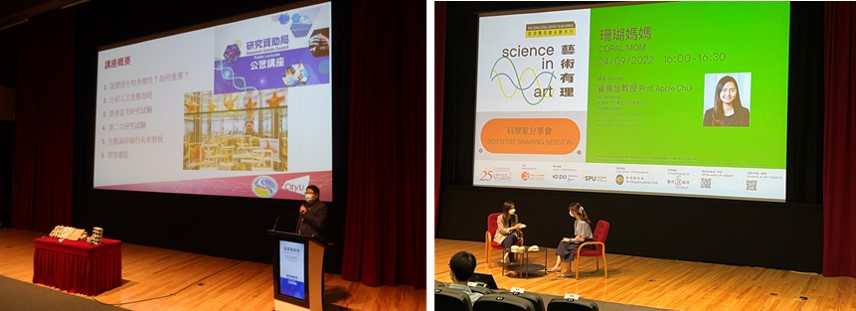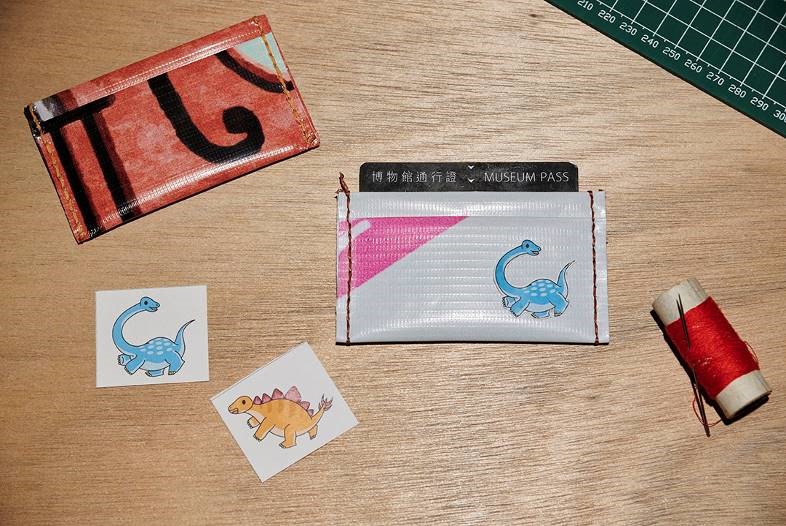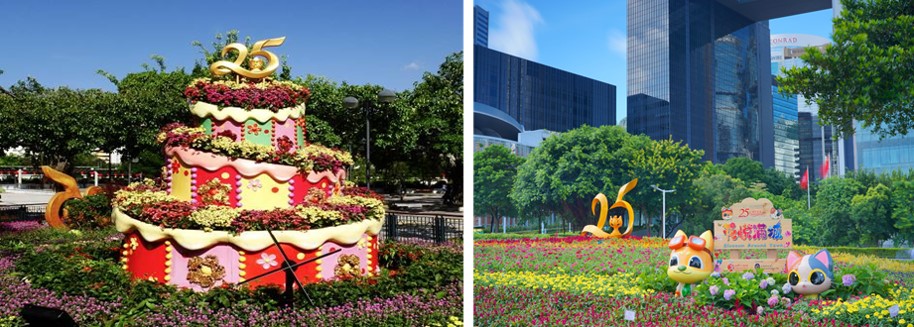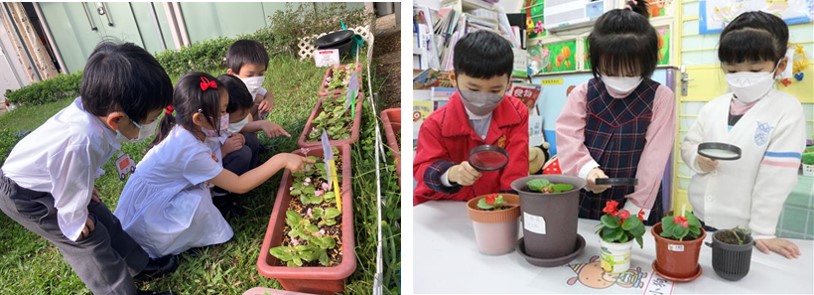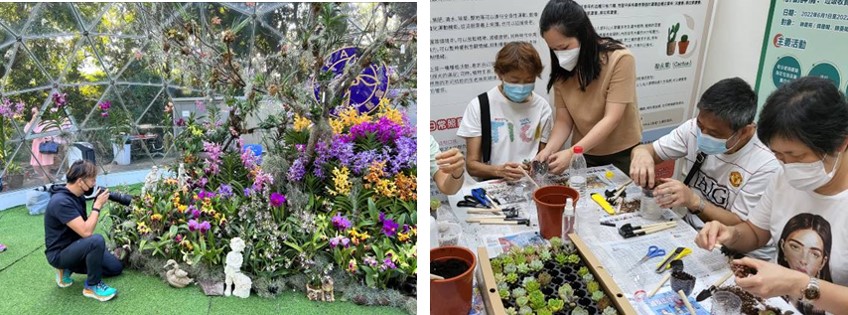 Environmental Report 2022Leisure and Cultural Services Department
Environmental Report 2022Leisure and Cultural Services Department
Chapter 3 - Environmental Management and Performance
(A) Providing Aesthetically Pleasing Open Space and Promoting Greening and Horticulture
| 3.1 | In providing aesthetically pleasing open space and promoting greening and horticulture, we have five areas of work. They are –
|
(I) Provision of Open Spaces that are Aesthetically Pleasing
| 3.2 | In 2022, five new open space facilities (including capital works projects and minor works projects) were opened, resulting in an increase of about 0.195 hectares of open space in Hong Kong. A list of these new facilities is shown at Annex I. |
| 3.3 | In general, 70% of the passive recreation areas will be used as landscape areas. Conspicuous flowering and shade trees, colour foliage and flowering shrubs of hardy species will be chosen to create colour contrast and seasonal changes. We aim to achieve sustainable landscaping through selection of more low maintenance and native plant species. |
| 3.4 | When planning new open space projects, the facility will be designed and constructed with consideration to environmental performance, such as application of energy-saving building services installations and use of environmental-friendly materials such as products with high recycled content. Appropriate materials should be used for creating a user-friendly and comfortable environment, and to achieve low recurrent maintenance cost. Apart from new open space projects, there are on-going improvement and upgrading works to existing parks and playgrounds. |
(II) Beautification of Existing Landscaped Areas
| 3.5 | In 2022, about 24 hectares of existing landscaped areas (including roadside amenity areas) were upgraded through the effort of district staff in carrying out landscape improvement works. We would continue to enhance the landscaping of parks and roadside amenity areas in order to provide a pleasant environment to the public. |
(III) Planting Programme
| 3.6 | Around 2.65 million trees, shrubs and annuals were planted in 2022 (breakdown at Annex II). We have continued the planting of flowering species to enhance the visual impact with more seasonal colours. |
(IV) Education and Promotion on Environmental Protection
| (a) | Horticulture Courses for the General Public |
| 3.7 | In 2022, we conducted 36 horticulture courses for 716 participants. |
| (b) | Guided Visits for Schools and Non-governmental Organisations (NGOs) |
| 3.8 | A total of 229 guided visits for 5 090 participants from schools and NGOs were organised in 2022, which included 157 school guided visits for 3 799 school children at the Hong Kong Zoological & Botanical Gardens, Green Education and Resource Centre, Kowloon Park, Hong Kong Park, Tai Po Waterfront Park and Tuen Mun Park. The guided visits were designed having regard to the curriculum on environmental education for primary schools. A total of 69 visits were also arranged for 1 212 children from kindergartens to tour around the Kowloon Park and Hong Kong Park. Children were introduced the basic knowledge and concept of plants, environmental conservation and the appropriate manners for visiting parks. Besides, free guided visits were arranged for 79 participants from three NGOs to tour around the Green Education and Resource Centre at the Kowloon Park.
|
| (c) | Conservation Courses for Uniformed Groups |
| 3.9 | The programmes provided a wide range of courses in gardening and arboriculture and aimed at promoting nature conservation. A total of seven conservation courses were organised for some 100 participants of the uniformed groups in 2022. Participants were involved in group discussions, lectures and guided visits. |
| (d) | Programmes and Exhibitions on Environmental Protection |
| 3.10 | To arouse public awareness on environmental issues, the Hong Kong Science Museum and Hong Kong Space Museum staged exhibitions and organised various programmes, including –
|
(V) Greening Activities
| 3.11 | The Department continuously promotes a green culture in the community through a series of educational and community involvement programmes. A total of 2 554 greening activities were organised in 2022, including – |
| (a) | Hong Kong Flower Show |
| 3.12 | The Hong Kong Flower Show 2022, originally scheduled to be held at Victoria Park from 11 to 20 March 2022, was cancelled in order to reduce the risk of spreading the COVID-19 epidemic. To celebrate the 25th Anniversary of the Establishment of the Hong Kong Special Administrative Region (HKSAR) and allow wide participation by the community in sharing the festive joy, the Department ran the Blossom Around Town programme from June to October 2022 for enhancing the public appreciation of gorgeous landscape displays and beautiful floral arrangements. The beautification works had been carried out in phases at parks and roadside amenity areas in various districts. Works included displays of colourful flowers and attractive plants with ornamental value to create a cheerful community atmosphere and enhance the cityscape across the territory. This programme was one of the many initiatives supported by the Hong Kong Jockey Club’s donation to the Government of the HKSAR to mark the 25th Anniversary of the Establishment of the HKSAR.
|
| (b) | Community Planting Day |
| 3.13 | The Department organised Community Planting Days to promote public awareness in greening. However, due to the COVID-19 epidemic, all originally scheduled planting events in 2022 were cancelled. |
| (c) | Green Volunteer Scheme |
| 3.14 | Green Volunteers were recruited in 18 districts to serve as stewards in greening promotion activities, and to assist in tree surveillance work and report problematic trees. They were encouraged to participate in greening their neighbourhood. In 2022, 81 greening activities were organised for the Green Volunteers with an attendance of about 3 900.
|
| (d) | Greening School Subsidy Scheme |
| 3.15 | In 2022, the Scheme attracted the participation of 890 schools and kindergartens for organising greening activities and implementing planting projects in their campuses with technical advice from horticultural instructors. |
| (e) | “One Person, One Flower” Scheme |
| 3.16 | The Scheme aimed at enhancing the knowledge of students about plants and cultivating their interests in growing them. In 2022, about 385 000 seedlings were distributed to students for them to nurture at home or in school.
|
| (f) | Greening Hong Kong Activities Subsidy Scheme |
| 3.17 | The Scheme aimed at encouraging the local community to organise more greening activities. In 2022, three organisations were subsidised under this Scheme to organise floral exhibition and horticultural workshop.
|
| (g) | Greening Exhibitions and Talks |
| 3.18 | Greening exhibitions and talks on horticulture were organised at the Hong Kong Zoological and Botanical Gardens and Green Education and Resource Centre at the Kowloon Park in 2022 with a view to educating and arousing public awareness in greening. A total of 205 exhibitions and talks were organised with some 18 000 participants. |
| (h) | Community Garden Programme |
| 3.19 | To encourage the public to participate actively in greening activities at the neighbourhood level and to adopt greening activities as part of daily life, 56 gardening courses were organised in 2022 with about 3 550 participants.
|
| (i) | Outreaching Greening Promotional Activities |
| 3.20 | The Department organised outreaching greening activities to promote greening and enhance public awareness in greening and environmental protection. In 2022, roving exhibitions at 32 leisure venues in 18 districts were arranged and attracted 21 180 visitors. Due to the COVID-19 epidemic, the outreaching promotional activities to organisations and schools were suspended.
|
(B) Preserving Cultural Heritage
| 3.21 | The Department, through the Conservation Office (CO), is committed to preserving all forms of Hong Kong’s cultural heritage. The CO provides conservation support for thematic exhibitions and preservation care and treatment for all collections pertaining to the public museums, Art Promotion Office and Intangible Cultural Heritage Office. |
| 3.22 | The CO devises, implements and evaluates conservation programmes for museum artifacts and heritage objects. Over the year, there were 430 objects and collections with various degree of deterioration treated and protected by the CO’s professional conservators. |
| 3.23 | Besides, the CO conducts technical examination and scientific studies on cultural heritage to support conservation work. In 2022, the CO conducted an extensive study on the emission of volatile pollutants in the display and storage environments of museums, with a focus on the ultra-trace level of corrosive gases. The findings provided valuable information in determining conservation strategies to mitigate the emission of pollutants within the museum environment.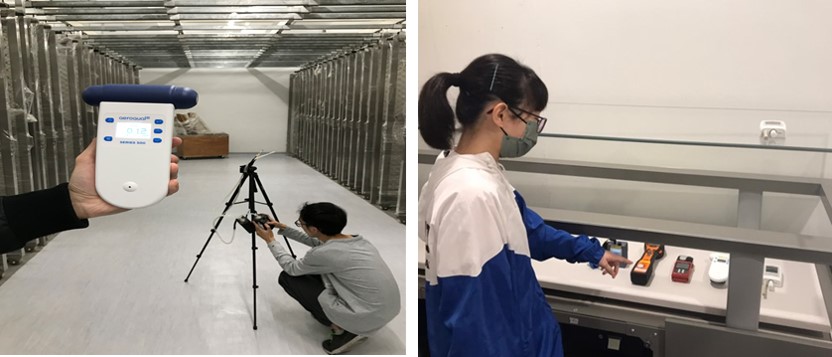 |
| 3.24 | The CO is dedicated to raising the awareness and support for conservation at all levels of the community by organising educational programmes and extension activities. In 2022, the CO supported and organised a variety of education programmes and activities for students and members of the public, such as the School Culture Day Scheme, the Muse Fest HK 2022 as well as a live streaming programme “Conservation Clinic on Silverware” on the “LCSD Plusss” Facebook page.
|
| 3.25 | It is firmly believed that cultural heritage not only provides an essential and irreplaceable link between the past, the present and the future, but is also fundamental to the sustainable development of our community as it forms the basic point of reference for our cultural identity, traditions and collective memory. |
| 3.26 | To ensure the continuous survival and well-being of cultural heritage, conservation, as well as community’s active engagement, are indispensable. |
(C) Practising Waste Reduction and Energy Saving
| 3.27 | We proactively explore ways to promote paper saving, energy saving and waste reduction, including conducting energy audits to identify good energy management practices. Measures/housekeeping practices adopted are detailed in the ensuing paragraphs. |
(I) Paper Saving
| 3.28 | The Department continued to adopt good practices on paper saving using “Reduce, Reuse, Recycle” strategy, particularly in replacing paper-based correspondences with electronic means. In 2022, we made the following endeavours –
|
(II) Energy Saving
| 3.29 | The Government has set a new “Green Energy Target” which seeks to further improve its use of energy by 6% for the period between 2020-21 and 2024-25, using comparable operating conditions in 2018-19 as the baseline. We shall play an active role to achieve the set goal and strive to integrate green features in our buildings/venues and adopt green practices as far as practicable. |
| (a) | Change in Energy Consumption | |||||||||
| 3.30 | The energy consumption of government buildings/venues under LCSD in 2018-19 and 2022-23 is tabulated below – | |||||||||
|
| 3.31 | The total energy consumption of government buildings/venues under LCSD decreased by 5.2% in 2022-23 as compared to 2018-19. Under the comparable operating conditions in 2018-19, there was a decrease of 7.6% in energy consumption in 2022-23. We will continue to implement various practicable housekeeping measures and best practices for energy saving as detailed under paragraphs 3.33 to 3.35 below. |
| 3.32 | The change in energy consumption has factored in significant changes in opening/closure of venues/facilities, addition/reduction of services, addition/removal of plants/equipment, extended/shortened service hours, increased/decreased demand for services, change of chairmanship of Building Management Committee1, etc. for a like-with-like comparison. | ||
|
|||
| (b) | Housekeeping Measures for Energy Saving |
| 3.33 | The following housekeeping measures for energy saving were commonly adopted in the Department’s offices and venues (including leisure venues, performance venues, libraries and museums) in 2022 –
|
| 3.34 | Apart from the above commonly adopted housekeeping measures, some venues also implemented other practicable measures that could address their operational characteristics or specific environment for energy saving –
|
| 3.35 | At the Headquarters building, the following practicable measures were also implemented –
|
(III) Carbon Reduction
| 3.36 | As part of the Government’s efforts in combating climate change, we conducted annual carbon audits for our major buildings with annual electricity consumption over 500 000 kWh so as to assess the carbon performance and identify room for emissions reduction. The carbon performance summary is available at the Department’s website. |
(IV) Water Saving
| 3.37 | The fresh water consumption of government buildings under LCSD in 2022 were 12.4 million cubic meters. Major water conservation measures adopted are listed below –
|
(V) Waste Reduction
| 3.38 | We have adopted the following waste reduction and other green measures –
|
(VI) Environmental Awareness among Staff
| 3.39 | For raising environmental awareness and promoting waste reduction, saving energy and natural resources among staff –
|
(VII) Clean Air Charter
| 3.40 | The Chief Executive signed the Clean Air Charter on behalf of the Government at the “Business for Clean Air” seminar organised by the Hong Kong General Chamber of Commerce on 27 November 2006. The Charter was initiated by the business sector in support of the Government’s appeal to improve air quality in Hong Kong. |
| 3.41 | As at 31 December 2022, we had a fleet of 152 vehicles. The total mileage was 1 373 897 km and the fuel consumption was 332 554 litres in 2022. The related emissions were about 6 030 kg of nitrogen oxides and 500 kg of respirable suspended particulates2. The total mileage and fuel consumption decreased by 6.2% and 6.1% respectively as compared with the figures recorded in 2021. Such decrease was mainly caused by the review of drivers’ driving practices and replacement of new departmental vehicles with Euro 6 emission standard. Moreover, we have implemented the following measures in support of the Government’s policy to improve air quality in Hong Kong –
|
| 3.42 | For improving indoor air quality (IAQ) and providing quality services to the public, we have engaged EMSD to carry out proper maintenance and retrofitting works for the ventilation and air-conditioning systems at our offices and venues. |
| 3.43 | In support of the Government’s drive of improving IAQ, we also participated in the IAQ Certification Scheme and engaged accredited IAQ Certificate Issuing Body to carry out regular IAQ inspection for LCSD venues/facilities served by central air-conditioning systems wherever practicable. In 2022, about 219 LCSD venues/facilities had participated in the Scheme. |
(D) Minimising Air and Noise Pollution in Organising Leisure and Cultural Activities
| 3.44 | We monitored closely the generator and machinery installed for activities to ensure that dark smoke emission would not exceed the prescribed requirement as stipulated in the relevant Regulations. |
| 3.45 | We monitored the noise level of outdoor events and ensure that they were within the limits set in the relevant Regulations. |
| 3.46 | Following the amendments to the Smoking (Public Health) Ordinance (Cap. 371) in 2006, statutory no smoking areas have been extended to cover all indoor workplaces and public places as well as some outdoor public places. The Department has implemented the smoking ban in these premises with effect from 1 January 2007. |

